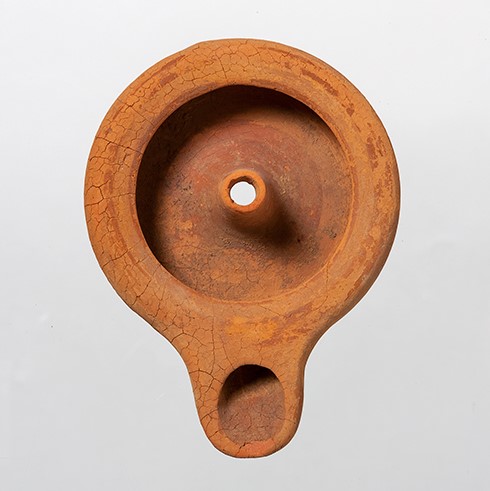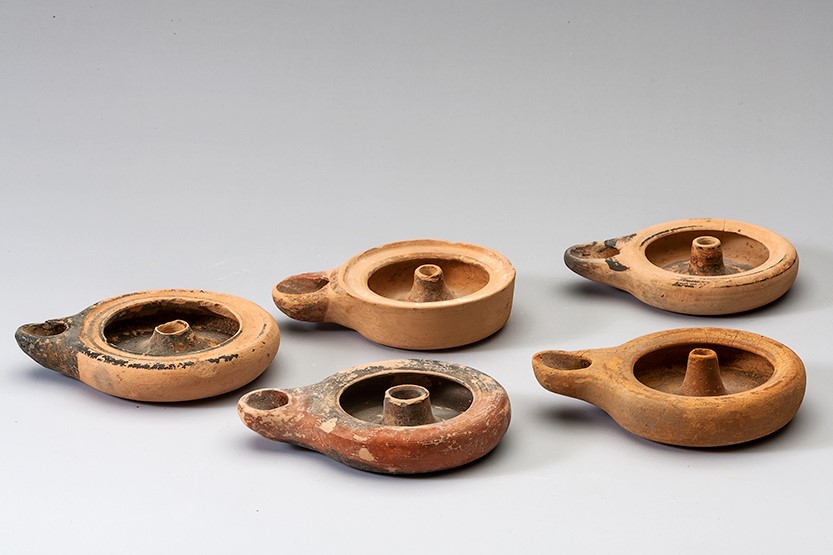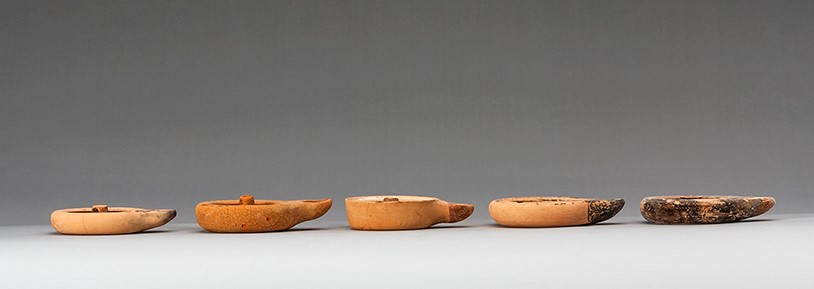Title: Sicilian Lamp - 1966.11
Acquisition number: 1966.11
Author or editor: J.R. Green
Culture or period: Sicilian.
Date: c. 7th - 4th century BC.
Material: Clay - Terracotta
Object type: Lamps - Terracotta
Dimensions: 106mm (l) × 80mm (w) × 22mm (h)
Origin region or location: Italy
Origin city: Possibly Gela.
Display case or on loan: 10
Keywords: Sicilian, Lamp, Gela, Woite Collection
J.R. Green with B. Rawson, Catalogue of Antiquities in the Australian National University, A.N.U. (Canberra, 1981) 80.
1966.11
Sicilian Lamp
Ht 2.2cm; diam. 8cm; length 10.6cm.
Orange clay. Intact but somewhat worn and with many fine cracks. Brown paint washed over the inside with bands on the inner and outer edges of the lip; the spout dipped.
From the Woite Collection; probably from the area of Gela, Sicily.
This type of lamp with central tube is particularly common in Sicily where it goes back to the seventh century (see Villard and Vallet, Melanges d’Archéologie et d'Histoire (Ecole Française de Rome) 67, 1955, 13) and continues at least to the second half of the fourth century: see for example Notizie degli Scavi di Antichità, Accademia Nazionale dei Lincei 1954, 112 fig. 36, 6, with concave rim like 1966.13 (also in this catalogue), about 475 bc; Notizie degli Scavi di Antichità, Accademia Nazionale dei Lincei 1956, 375 figs. 2 and 3, third quarter of the fifth century, like 1966.10 (in this catalogue); Notizie degli Scavi di Antichità, Accademia Nazionale dei Lincei 1962, 374 fig. 37f and h, third quarter of the fourth century; Archeologia Classica 11, 1957, pl. 26, 1, later fourth century (with Orlandini’s important discussion of chronology). Note also A.Adriani et al. (eds), Himera I (Rome 1970) 292ff. and pl. 69, 6-7, and the comments by C.L. Lyons, Morgantina Studies V. The Archaic Cemeteries (Princeton 1996) 69-71.
In Athens the type is less popular. Scheibler, Kerameikos XI: Griechische Lampen 44ff. and pll. 42-47, shows that the majority belong to the period 350-260 bc although early forms run back through the fifth century: cf. Howland, The Athenian Agora iv: Greek Lamps and their Survivals, type 22A, pl. 35 and pl. 7, esp. no. 193.
The purpose of the central tube is not entirely certain. It has been suggested that it was to take the point of a stick stuck into the (earth) floor as a simple lampstand. One may note, however, that this type does not have a handle, and D.M. Bailey, A Catalogue of the Lamps in the British Museum, i, Greek, Hellenistic, and Early Roman Pottery Lamps (London 1975) 14, following Howland 24, suspects they were merely a device which made holding the lamp easier. Compare the Sicilian examples illustrated in his pll. 120-123.
See 1966.01-1966.42 in this catalogue for all material from the Woite Collection in the ANU collection.
J.R. Green with B. Rawson, Catalogue of Antiquities in the Australian National University, A.N.U. (Canberra, 1981) 80.


